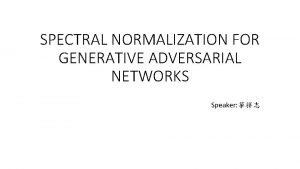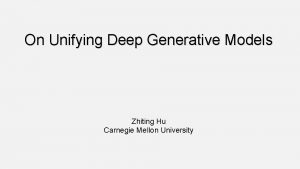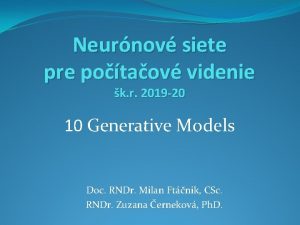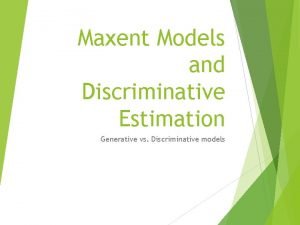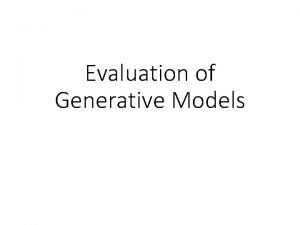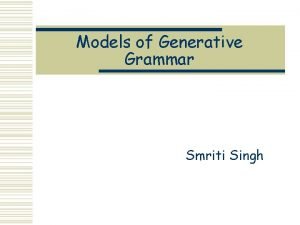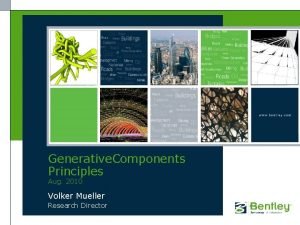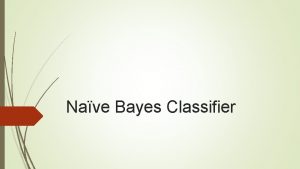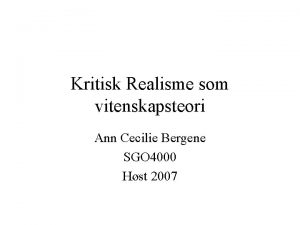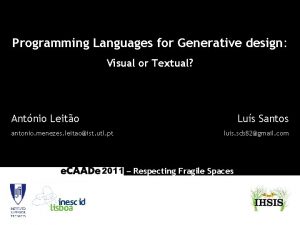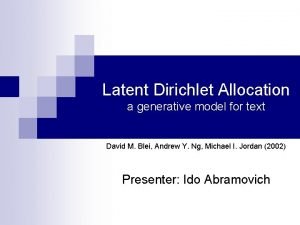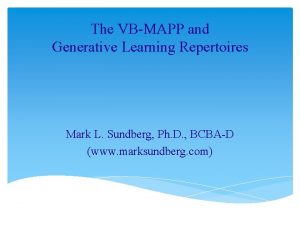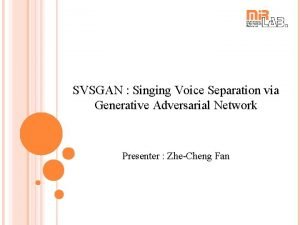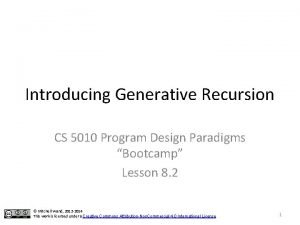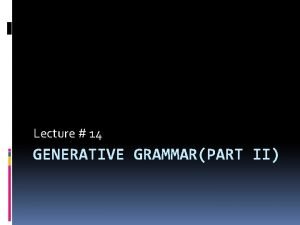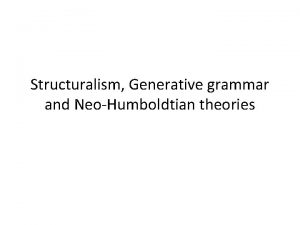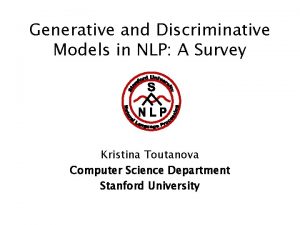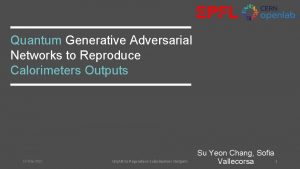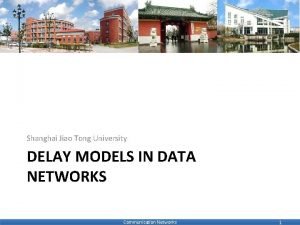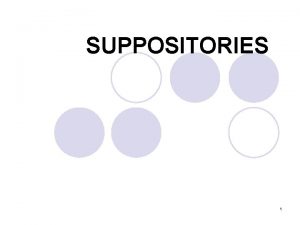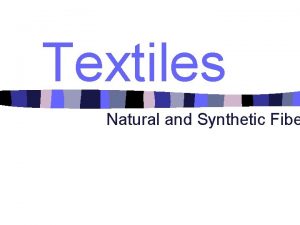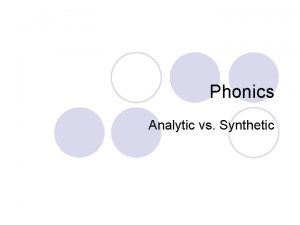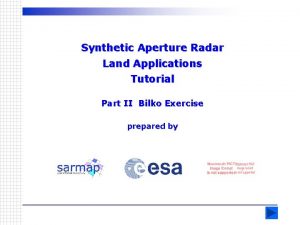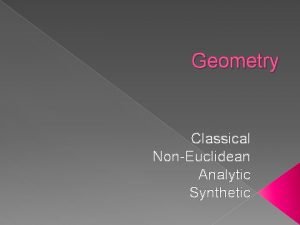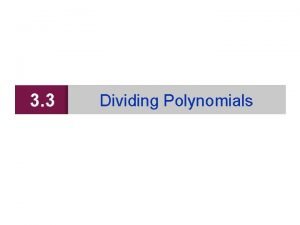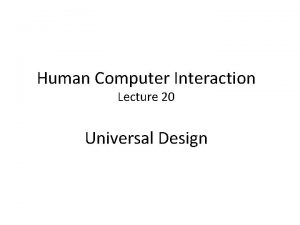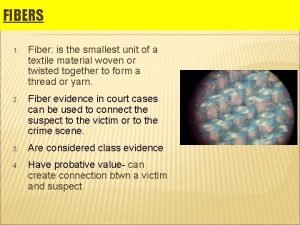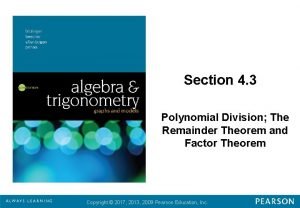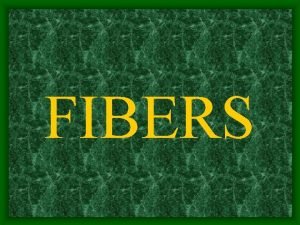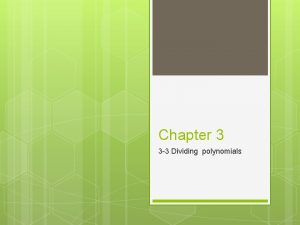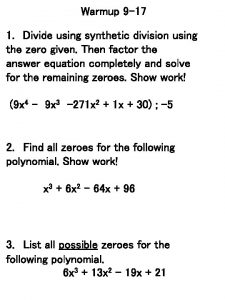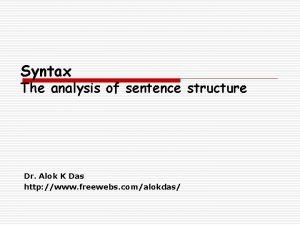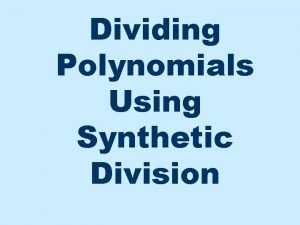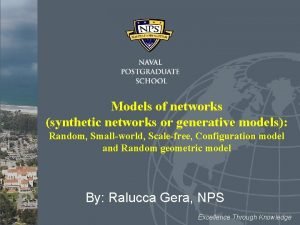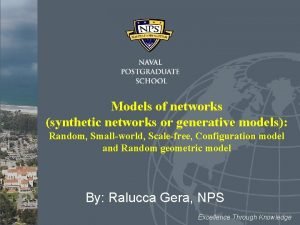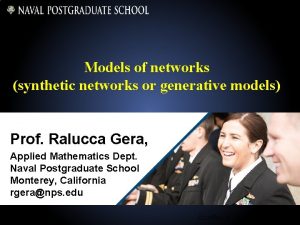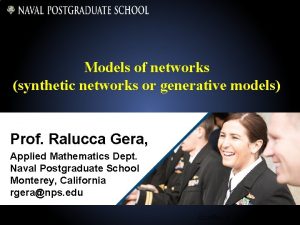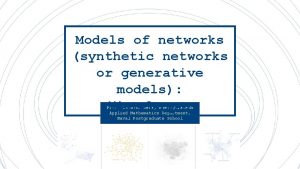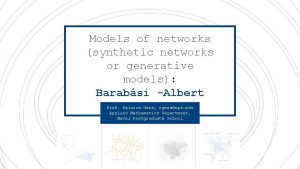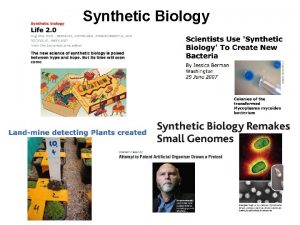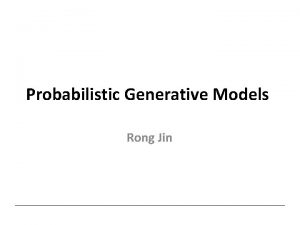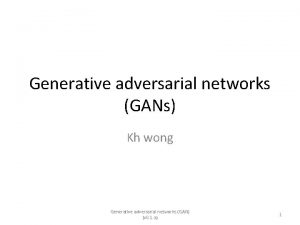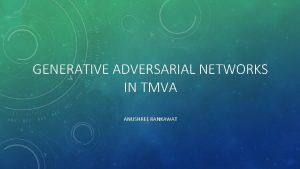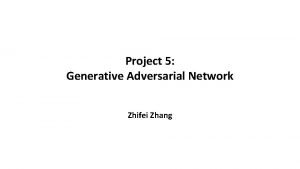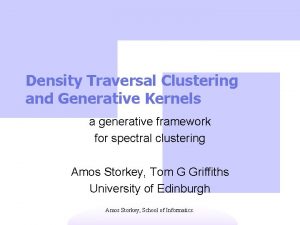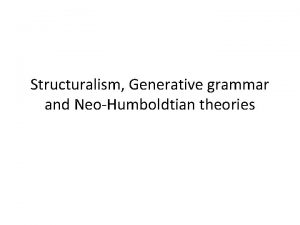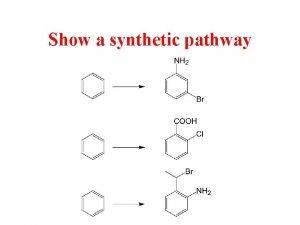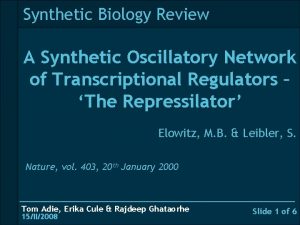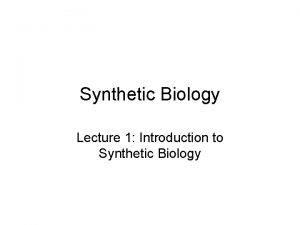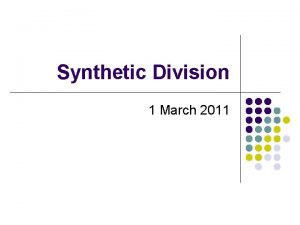Models of networks synthetic networks or generative models





















































- Slides: 53

Models of networks (synthetic networks or generative models) Prof. Ralucca Gera, Applied Mathematics Dept. Naval Postgraduate School Monterey, California rgera@nps. edu Excellence Through Knowledge

Learning Outcomes • Identify network models and explain their structures; • Contrast networks and synthetic models; • Understand how to design new network models (based on the existing ones and on the collected data) • Distinguish methodologies used in analyzing networks.

The three papers for each of the models Synthetic models are used as reference/null models to compare against and build new complex networks • “On Random Graphs I” by Paul Erdős and Alfed Renyi in Publicationes Mathematicae (1958) Times cited: ∼ 3, 517 (as of January 1, 2015) • “Collective dynamics of ‘small-world’ networks” by Duncan Watts and Steve Strogatz in Nature, (1998) Times cited: ∼ 24, 535 (as of January 1, 2015) • “Emergence of scaling in random networks” by László Barabási and Réka Albert in Science, (1999) Times cited: ∼ 21, 418 (as of January 1, 2015) 3

Why care? • Epidemiology: – A virus propagates much faster in scale-free networks. – Vaccination of random nodes in scale free does not work, but targeted vaccination is very effective • Create synthetic networks to be used as null models: – What effect does the degree distribution alone have on the behavior of the system? (answered by comparing to the configuration model) • Create networks of different sizes – Networks of particular sizes and structures can be quickly and cheaply generated, instead of collecting and cleaning the data that takes time

Reference network: Regular Lattice • 5 Source: http: //mathworld. wolfram. com/Circulant. Graph. html

Reference network: Regular Lattice Source: http: //mathworld. wolfram. com/Circulant. Graph. html 6

Reference network: Regular Lattice • The higher dimensions are generalizations of these. An example is a hexagonal lattice is a 2 -dimensional lattice: graphene, a single layer of carbon atoms with a honeycomb lattice structure. 7 Source: http: //phys. org/news/2013 -05 -intriguing-state-previously-graphene-like-materials. html

Erdős-Rényi Random Graphs (1959) 8

Random graphs (Erdős-Rényi , 1959) • 9

Creating G(n, m) • 10

Creating G(n, m) – method 2 • 11

Creating G(n, p) • 12

Results about E-R graphs: • 13

Generating Erdős-Rényi ER(n, p) • ER graphs are models of a network in which some specific set of parameters take fixed values, but the construction of the network is random (see below in Gephi) 14

Generating Erdős-Rényi ER(n, m) 15

Generating Erdős-Rényi random networks Reference for python: http: //networkx. lanl. gov/reference/generated/networkx. generators. random_graphs. erdos_renyi_graph. html#networkx. generators. random_graphs. erdos_renyi_graph 16

The Random Geometric model 17

Random Geometric Model • 18

An example of a random geometric 19 https: //www. youtube. com/watch? v=NUisb 1 -INIE

Creating it in Python https: //networkx. github. io/documentation/networkx 1. 10/reference/generated/networkx. generators. geometric. random_geometric_graph. html#networkx. generators. geometric. random_geometric_graph 20

The Malloy Reed Configuration model (1995) 21

The configuration model • A random graph model created based on Degree sequence of choice (can be scale free) • Maybe more than degree sequence is needed to be controlled in order to create realistic models 22

The MR configuration model • A random graph model created based on a degree sequence of choice: 4, 3, 2, 2, 2, 1, 1, 1 Step 1: Step 2: Or this step 2: 23

Mathematical properties • 24

Mathematical properties (parallel edges) • 25 http: //tuvalu. santafe. edu/~aaronc/courses/5352/csci 5352_2017_L 4. pdf

Mathematical properties (loops) • 26 http: //tuvalu. santafe. edu/~aaronc/courses/5352/csci 5352_2017_L 4. pdf

Generating it in Python https: //networkx. github. io/documentation/networkx-1. 10/reference/generated/networkx. generators. degree_seq. configuration_model. html 27

Part 2 28

Coding it in Co. Calc • Go to www. Co. Calc. com and create an account using your NPS email • Create your new folder to copy the code • Open “MA 4404 -2019” folder to copy its contents to your new folder. 29

Copy contents to NEW folder 30

Make a copy • Choose “Create. Synthetic. Networks. ipynb” • Notice projects, folders & files 31

Create ER networks 32

Watts-Strogatz Small World Graphs (1998) 33

Small world models • Duncan Watts and Steven Strogatz small world model: a few random links in an otherwise structured graph make the network a small world: the average shortest path is short regular lattice (one type of structure): my friend’s friend is always my friend small world: mostly structured with a few random connections Source: Watts, D. J. , Strogatz, S. H. (1998) Collective dynamics of 'small-world' networks. Nature 393: 440 -442. random graph: all connections happen at random

Small worlds, between order and chaos Small worlds the graph on the left has order (probability p =0), the graph in the middle is a "small world" graph (0 < p < 1), the graph at the right is complete random (p=1). Source: http: //www. bordalierinstitute. com/target 1. html

Variations of avg path and clustering as a function of the rewiring probability p 36 https: //pdfs. semanticscholar. org/8 c 4 c/455 de 44 fa 99 e 73 e 79 d 6 fddf 008 ca 6 ae 0 f 9 aa. pdf

Generating Watts-Strogatz WS (n, k, alpha) Alpha is the rewiring probability 37

Generating Watts-Strogatz networks. 15 is the rewiring probability http: //networkx. lanl. gov/reference/generated/networkx. generators. random_graphs. watts_strogatz_graph. html#networkx. generators. random_graphs. watts_strogatz_graph 38

Barabási-Albert Scale free model (1999) 39

Network growth & resulting structure • Random attachment: new node picks any existing node to attach to • Preferential/fitness attachment: new node picks from existing nodes according to their degrees/fitness (high preference for high degree/fitness) http: //projects. si. umich. edu/netlearn/Net. Logo 4/RAnd. Pref. Attachment. html

Scale-free •

Power law networks number of nodes of that degree • Many real world networks contain hubs: highly connected nodes • Usually the distribution of edges is extremely skewed many nodes with small degree No “typical” degree node fat tail: a few nodes with a very large degree Degree (number of edges)

But is it really a power-law? Log of number of nodes of that degree • log of the degree

Fitting distributions Node (frame) and edge (inset) counts of European Airline Transportation Network's layers with distribution fitting. 44 http: //faculty. nps. edu/rgera/ANGEL. html

Fitting distributions European Airline Transportation Network's multilayer network: Degree histogram of the multiplexes with the log scale in the inset. Upper right: average shortest path, lower right: centrality coefficient, per node http: //faculty. nps. edu/rgera/ANGEL. html 45

Scale Free networks • 46

Generating Barabasi-Albert 47

Generating Barabasi-Albert networks http: //networkx. lanl. gov/reference/generated/networkx. generators. random_graphs. barabasi_albert_graph. html#networkx. generators. random_graphs. barabasi_albert_graph 48

Modified BA • Many modifications of this model exists, based on: – Nodes “retiring” and losing their status/outdated – Nodes disappearing (such as website going down) – Links appearing or disappearing between the existing nodes (called internal links) – Fitness of nodes (modeling newcomers like Google) • Most researchers still use the standard BA model when studying new phenomena and metrics. – It is a simple model (allows consistent research) that has growth and preferential attachment – One can add more conditions to this basic model, in 49 order to mimic reality

A zoo of complex networks 50

Random, Small-World, Scale-Free Scale Free networks: 1. High degree heterogeneity 2. Various levels of modularity 3. Various levels of randomness Man made, “large world”: 51 http: //noduslabs. com/radar/types-networks-random-small-world-scale-free/

Main References • Newman “The structure and function of complex networks” (2003) • Estrada “The structure of complex Networks” (2012) • Barabasi “Network Science” (online: http: //barabasi. com/networksciencebook/) • References to the classes that exist in python: http: //networkx. lanl. gov/reference/generators. html 52

Back to coding in Co. Calc 53
 Spectral normalization for generative adversarial networks
Spectral normalization for generative adversarial networks Conditional generator
Conditional generator Unsupervised image to image translation
Unsupervised image to image translation Do deep generative models know what they don’t know?
Do deep generative models know what they don’t know? Zhiting hu
Zhiting hu Taxonomy of generative models
Taxonomy of generative models Generative vs discriminative models
Generative vs discriminative models A note on the evaluation of generative models
A note on the evaluation of generative models Phrase structure rules
Phrase structure rules Generative type computer aided process planning
Generative type computer aided process planning Hudson culture ladder
Hudson culture ladder Bentley generative components
Bentley generative components Bayes intranet
Bayes intranet Structural linguistic and behavioral psychology
Structural linguistic and behavioral psychology Eksempler på kritisk realisme
Eksempler på kritisk realisme Generative design grasshopper
Generative design grasshopper Generative lymphoid organs
Generative lymphoid organs Lda generative model
Lda generative model Vb-mapp level 1 milestones
Vb-mapp level 1 milestones Singing
Singing Generative recursion
Generative recursion Generative grammar examples
Generative grammar examples Generative thinking boards
Generative thinking boards Generative thinking definition
Generative thinking definition From structuralism to transformational generative grammar
From structuralism to transformational generative grammar Generative meditation
Generative meditation Surface structure
Surface structure Nlp generative model
Nlp generative model Quantum generative adversarial learning
Quantum generative adversarial learning A switched wan is normally implemented as a network
A switched wan is normally implemented as a network Basestore iptv
Basestore iptv Delay models in data networks
Delay models in data networks What are modals and semi modals
What are modals and semi modals Cubism characteristics
Cubism characteristics Synthetic data
Synthetic data Learn composition of various synthetic bases
Learn composition of various synthetic bases Synthetic fibe
Synthetic fibe Difference between analytic and synthetic phonics
Difference between analytic and synthetic phonics Synthetic aperture radar tutorial
Synthetic aperture radar tutorial Father of analytical geometry
Father of analytical geometry Synthetic personalisation
Synthetic personalisation Polynomial table
Polynomial table Synthetic language
Synthetic language Synthetic sounds used to convey information
Synthetic sounds used to convey information Smallest unit of any textile material is
Smallest unit of any textile material is Synthetic division and the remainder theorem assignment
Synthetic division and the remainder theorem assignment Synthetic
Synthetic Synthetic division worksheet doc
Synthetic division worksheet doc Synthetic division
Synthetic division Complex sentence tree diagram
Complex sentence tree diagram Synthetic function of liver
Synthetic function of liver Polynomial long division shortcut
Polynomial long division shortcut Oil sands extraction process diagram
Oil sands extraction process diagram Terylene clothes
Terylene clothes
